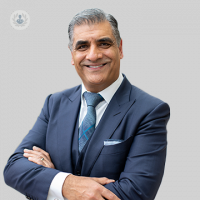Atrial fibrillation: how to reduce stroke risk
Written in association with:Atrial fibrillation (AF) is an irregular heartbeat that can lead to clots, stroke and heart failure. Patients with AF are five times more likely to develop stroke if the condition is left without adequate treatment.
Here, one of our top cardiothoracic surgeons Mr Inderpaul Birdi explains the treatment options the Watchman Device and the minimally invasive LAA clip procedure, which are used to reduce the risk of stroke.

What is the left atrial appendage and how can it cause a stroke?
The left atrial appendage (LAA) is a small sac in one of the chambers of the heart called the left atrium. It is a major source of stroke-forming clots in patients with atrial fibrillation. When a patient develops atrial fibrillation, the heart condition causes an irregular and abnormally fast heart rate. This reduces the efficiency of cardiac function. This leads to symptoms such as:
- Irregular heartbeat
- Palpitations
- Shortness of breath
- Dizziness
- Lethargy
Stasis of blood within the left atrium, and especially in the LAA, leads to the development of clots that can fly out of the heart and into the brain causing a stroke. As atrial fibrillation continues, the left atrium dilates and leads to the development of leaking heart valves, which further exacerbate the situation.
How is atrial fibrillation managed?
Patients are usually required to take a blood thinner such as warfarin or other newer alternatives. All of these drugs, however, can increase the risk of bleeding tendency and that can sometimes be a danger to life.
Many patients do not like to take blood thinners or are intolerant to them. In these patients, it is important to consider other forms of treatment to reduce the risk of clot formation.
What is the Watchman Device?
The Watchman Device is a small implant placed into the heart. It is used to reduce the risk of clot embolism in patients with atrial fibrillation who do not have associated valve disease. The implantation of the Watchman Device into the left atrial appendage (LAA) closes off the appendage to prevent any clots forming inside.
The Watchman Device is not always successful, either because it cannot be safely deployed or it does not completely occlude the LAA and therefore does not fulfil its primary goal. In these patients, minimally invasive LAA Clip is an option.
Who is not suitable for the Watchman Device?
The Watchman Device is unsuitable for the following patients:
- Those who cannot take warfarin, aspirin or clopidogrel
- Patients who should not or cannot undergo heart catheterisation procedures
- Patients with an LAA that is too large or too small to fit the device
What is the LAA clip (Atriclip Device)?
During the minimally invasive LAA clip procedure, the surgeon uses a specially designed device like the Atriclip. The secure clip is placed onto the outside of the LAA under telescopic vision. The procedure usually takes 15 to 30 minutes and is performed under a general anaesthetic. It has a higher success rate than the Watchman Device.
Once the LAA is successfully occluded, the patient is more likely to discontinue warfarin after surgical occlusion. Surgeons also occlude the LAA during other forms of heart surgery in patients with atrial fibrillation.
Do not hesitate to book an appointment with Mr Birdi if you would like to discuss your atrial fibrillation treatment options.


